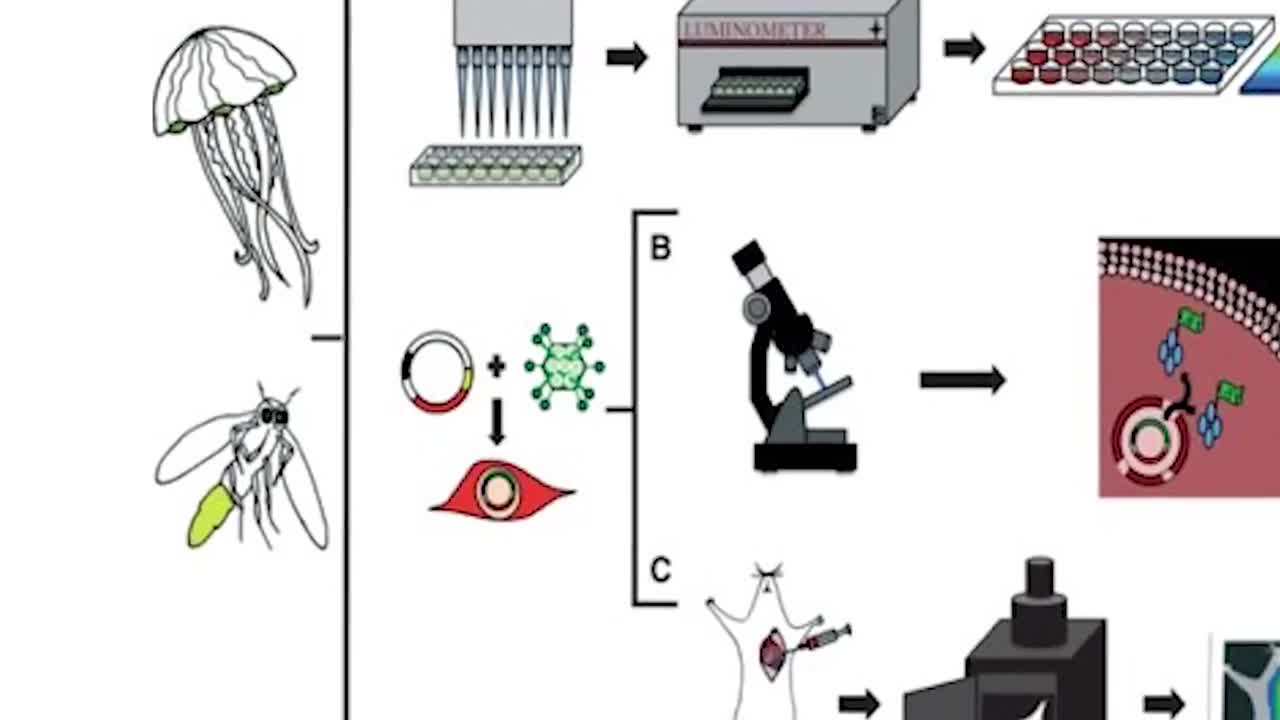Premium Only Content

Luciferase-Modified Magnetic Nanoparticles in Medical Imaging
I believe this is possibly why the Jellyfish genes are in the Phizer. Gonna make you glow.
Watch this one about Gates, Darpa and Luciferace...
Published on May 9, 2017
By Philip Renkert, Emily Chen, and Megan Mazzatenta
Bioluminescent animals such as fireflies and dinoflagellates produce natural light in order to find mates and to protect their species from predators, but that same light has potential to greatly improve current medical practices. Medical imaging is crucial for tracking the progress of disease throughout the human body, but the synthesized chemicals currently used in the process inflict additional harm on the body, leaving scientists searching for a less invasive imaging method. By processing magnetic nanoparticles that are coated in luciferase, the main enzyme involved in bioluminescence, cells can be individually tracked in a natural, non-toxic manner.
In animals, agitation from the environment creates a flow of protons that bring the enzyme luciferase in contact with the compound luciferin. The luciferin is then oxidized in the presence of other compounds, such as adenosine triphosphate, and photons are released to generate light. Luciferase can be applied to track and image the growth of diseases, like cancer, noninvasively. Current medical imaging often requires the use of radiology, but because these techniques involve large amounts of radiation, there is often damage to the body. The light produced from the luciferase reaction is what gives the magnetic nanoparticles the ability to expose abnormal cell growth patterns, eliminating the need for other light sources that could harm the cells. A sensitive charge-coupled device camera can then be used to create a clear picture of the growth patterns by detecting the position of emitted light over time.
In processing luciferase for potential medical use in animals and humans, superparamagnetic iron oxide magnetic nanoparticles must first be synthesized by precipitating magnetite from a solution of ferric and ferrous ions. A polymer layer is added to prevent the particles from aggregating, and then the luciferase shell is added. The resultant processed MNP has a core with cubic spinel structure and is 40-119 nanometers in diameter. The superparamagnetic property of the nanoparticles can allow for cell manipulation by an external magnetic field. The cells targeted by certain nanoparticles can then be neutralized to lose function or separated from healthy ones. The nanoscale of the particles also allows for the tracking and manipulation of each cell individually, which can be done in a natural, safe way using the luciferase-modified MNPs.
In this video, we will explore the applications and possible drawbacks of the use of luciferase-modified magnetic nanoparticles in the medical imaging field.
References:
1. Cancer Gene Therapy and Cell Therapy. American Society of of Gene & Cell Therapy. http://www.asgct.org/general-public/e...
2. Dikmen, Z. G. A New Diagnostic System in Cancer Research: Bioluminescent Imaging (BLI). TUBITAK, 35 (2005) 65-70. http://journals.tubitak.gov.tr/medica...
3. Gupta, A. K.; Gupta, M. Synthesis and surface engineering of iron oxide nanoparticles for biomedical applications. Biomaterials 2005, 26(18), 3995–4021 DOI: 10.1016/j.biomaterials.2004.10.012.
4. Kocher, B.; Piwnica-Worms, D. Illuminating Cancer Systems With Genetically-Engineered Mouse Models and Coupled Luciferase Reporters In Vivo. Cancer discovery 2013, 3(6) 616-629 DOI: 10.1158/2159-8290.CD-12-0503.
5. Meroni, G.; Rajabi, M.; Santaniello, E. D-Luciferin, derivatives and analogues: synthesis and in vitro/in vivo luciferase-catalyzed bioluminescent activity. ARKIVOC 2009, 265-288.
6. Okabe, Y. Quantum dots for in vivo imaging: Disadvantages of Quantum Dots. University of California, Irvine. http://bme240.eng.uci.edu/students/07...
7. Roura, S.; Gálvez-Montón, C.; Bayes-Genis, A. Bioluminescence imaging: a shining future for cardiac regeneration. Journal of Cellular and Molecular Medicine 2013, 17(6) 693-703 DOI: 10.1111/jcmm.12018.
8. Sadikot, R.T.; Blackwell, T.S. Bioluminescence Imaging. Proceedings of the American Thoracic Society 2005, 2(6) 537-540 DOI: 9.1513/pats.200507-067DS.
9. Vasquez, E. S.; Feugang, J. M.; Willard, S. T.; Ryan, P. L.; Keisha, W. B. Journal of Nanobiotechnology 2016, 14 (20), DOI: 11.1186/s12951-016-0168-y.
10. Xu, T.; Close, D.; Handagama W.; Marr E.; Sayler G.; Ripp S. The Expanding Toolbox of In Vivo Bioluminescent Imaging. Frontiers in Oncology 2016, 6(150) DOI: 10.3389/fonc.2016.00150.
11. Zborowski, M.; Chalmers, J. J.; Lowrie, W. G. Magnetic Cell Manipulation and Sorting. Microsystems and Nanosystems Microtechnology for Cell Manipulation and Sorting 2016, 15–55 DOI: 10.1007/978-3-319-44139-9_2.
Sources: Images, Video Clips, and Audio
https://docs.google.com/document/d/1I...
-
 1:39:50
1:39:50
Graham Allen
3 hours agoOur 1,000th Episode! Epstein AGAIN! The TRUTH About Our Movement! + JD Vance Must Be 48!
150K716 -
 2:59:40
2:59:40
Wendy Bell Radio
7 hours agoPass The Blame
48.3K88 -
 LIVE
LIVE
Caleb Hammer
12 hours agoI F*cking Hate Them | Financial Audit
410 watching -

The Big Mig™
2 hours agoLetter of Marque & Reprisal Authorization Act LFG!
3.44K9 -
 1:08:12
1:08:12
Chad Prather
22 hours agoThe Cost of Calling: Why Some Leave and Others Rise
79.5K21 -
 4:14
4:14
Gun Owners Of America
2 hours agoMissouri's 2A Protection Act Is Dead—The DOJ Killed It.
11.4K15 -
 2:37:05
2:37:05
The Chris Salcedo Show
18 hours ago $3.96 earnedCounting The Days 'Til Christmas
39K1 -
 15:13
15:13
Demons Row
15 hours ago $2.58 earnedRiding Away from Everything I Knew | MotoVlog
39.5K2 -
 8:13
8:13
Degenerate Jay
17 hours ago $3.55 earnedAssassin's Creed Black Flag Remake Just Keeps Leaking 😂
37.2K1 -
 3:35
3:35
Blackstone Griddles
20 hours agoPork Dumpling Smashed Tacos on the Blackstone Griddle
26.6K1